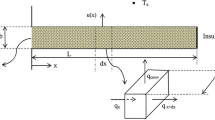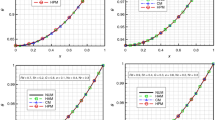Abstract
The thermal characteristics of annular porous fins with rectangular and hyperbolic cross-sections and internal heat generation were comprehensively studied by the homotopy perturbation method (HPM). The convective–conductive–radiative mode of heat transfer was considered in the current analysis. All thermal parameters were considered as a function of temperature. An approximate closed-form solution was obtained by solving the nonlinear heat transfer equation using HPM. Darcy’s model was employed to formulate the governing equation of heat transfer through porous media. Unknown constants were the initial approximations of the solution and were evaluated based on the boundary and initial conditions of the problem. The effects of pores and different thermal parameters on the dimensionless temperature distribution and the fin efficiency were graphically presented. In order to evaluate the accuracy of the closed-form solution, the obtained results (for both dimensional and non-dimensional forms) were validated by numerical solutions.











Similar content being viewed by others
Abbreviations
- A c :
-
Cross-sectional area of fin (m2)
- C p :
-
Specific heat of fluid (J g−1 K−1)
- D a :
-
Darcy Number
- e :
-
Co-efficient of linear variation of heat generation per unit volume (K−1)
- e o :
-
Dimensionless co-efficient for linear variation of heat generation per unit volume
- Gr:
-
Grashof Number
- g :
-
Gravitational constant (9.81 m s−2)
- h :
-
Convective heat transfer coefficient (W m−2 K−1)
- h o :
-
Convective heat transfer coefficient at fin base temperature Tb (W m−2 K−1)
- k s, k f :
-
Thermal conductivity of solid, fluid (W m−1 K−1)
- k eff :
-
Effective thermal conductivity of porous matrix (W m−1 K−1)
- k r :
-
Ratio of thermal conductivity of solid to that of fluid at ambient temperature Ta
- \(k_{{\text{s}}}^\text{o} ,\;k_{{\text{f}}}^\text{o}\) :
-
Thermal conductivity of solid and fluid at temperature Ta (W m−1 K−1)
- \(k_{{{\text{eff}}}}^\text{o}\) :
-
Effective thermal conductivity of porous matrix at temperature Ta (W m−1 K−1)
- m :
-
Exponent for variation of thickness of fin
- ṁ :
-
Mass flow rate of fluid (kg s–1)
- n :
-
Exponent of variable convective heat transfer coefficient
- N c :
-
Non-dimensional convection parameter
- N cc :
-
Non-dimensional conduction–convection parameter
- N r :
-
Non-dimensional radiation parameter
- P r :
-
Prandtl Number
- P :
-
Perimeter enclosing the cross-sectional area of the fin (m)
- q :
-
Heat flow from base to tip of the fin (W)
- q o :
-
Internal heat generation at Ta (W m−3)
- Q * :
-
Non-dimensional heat generation parameter
- R a :
-
Rayleigh Number
- R :
-
Dimensionless radius
- r i, r o, t b :
-
Inner radius, outer radius and thickness of the fin at the base (m)
- T b, T a and T s :
-
Base temperature of fin, ambient temperature and radiation sink temperature (K)
- α f :
-
Thermal diffusivity (m2 s–1)
- β :
-
Co-efficient of volumetric thermal expansion of fin (K−1)
- ε :
-
Surface emissivity of the fin
- ε o :
-
Surface emissivity at the sink temperature Ts
- η :
-
Efficiency of the fin
- θ :
-
Dimensionless temperature
- θ a :
-
Dimensionless ambient temperature
- θ s :
-
Dimensionless radiation sink temperature
- κ :
-
Permeability of porous media (m2)
- κ 1, κ 2 :
-
Co-efficient of thermal conductivity of solid and fluid (K−1)
- λ :
-
Co-efficient of linear variation of emissivity (K−1)
- λ o :
-
Dimensionless co-efficient for linear variation of emissivity
- ν f :
-
Kinematic viscosity of fluid (m2s–1)
- ρ :
-
Density of fluid (kg m−3)
- σ :
-
Stefan–Boltzmann Constant (5.67 × 10–8 W m–2 K–4)
- ϕ :
-
Porosity of the fin
- τ w :
-
Variable thermal conductivity parameter for solid–fluid interaction
References
Kern DQ, Kraus DA. Extended surface heat transfer. New York: McGraw-Hill; 1972.
Incropera F, DeWitt DP, Bergman TL, Lavine AS. Fundamentals of heat and mass transfer. New York: Wiley; 2007.
Kraus AD, Aziz A, Welty JR. Extended surface heat transfer. New York: Wiley; 2001.
Razelos P. A critical review of extended surface heat transfer. Heat Transf Eng. 2003;24:1–28.
Bayrak F, Hakan OF, Selimefendigil F. Effects of different fin parameters on temperature and efficiency for cooling of photovoltaic panels under natural convection. Sol Energy. 2019;188:484–94.
Sheikholeslami M, Haq R, Shafee A, Li Z, Elaraki YG, Tlili I. Heat transfer simulation of heat storage unit with nanoparticles and fins through a heat exchanger. Int J Heat Mass Transf. 2019;135:470–8.
Selimefendigil F, Öztop HF. Fuzzy-based estimation of mixed convection heat transfer in a square cavity in the presence of an adiabatic inclined fin. Int Commun Heat Mass Transf. 2012;39:1639–46.
Selimefendigil F, Öztop HF. Numerical analysis of laminar pulsating flow at a backward facing step with an upper wall mounted adiabatic thin fin. Comput Fluids. 2013;88:93–107.
Selimefendigil F, Oztop HF, Chamkha AJ. MHD mixed convection in a nanofluid filled vertical lid-driven cavity having a flexible fin attached to its upper wall. J Therm Anal Calorim. 2019;135:325–40.
Kiwan S, Al-Nimr MA. Using porous fins for heat transfer enhancement. J Heat Transf. 2001;123:790–5.
Kahalerras H, Targui N. Numerical analysis of heat transfer enhancement in a double pipe heat exchanger with porous fins. Int J Numer Methods Heat Fluid Flow. 2008;18:593–617.
Kiwan S. Effect of radiative losses on the heat transfer from porous fins. Int J Therm Sci. 2007a;46(10):1046–55.
Kiwan S, Zeitoun O. Natural convection in a horizontal cylindrical annulus using porous fins. Int J Numer Methods Heat Fluid Flow. 2008;18(5):618–34.
Sheikholeslami M. New computational approach for exergy and entropy analysis of nanofluid under the impact of Lorentz force through a porous media. Comput Methods Appl Mech Eng. 2019;344:319–33.
Saedodin S, Sadeghi S. Temperature distribution in long porous fins in natural convection condition. Middle-East J Sci Res. 2013;13(6):812–7.
Talukdar P, Mishra SC, Trimis D, Durst F. Heat transfer characteristics of a porous radiant burner under the influence of a 2-D radiation field. J Quant Spectrosc Radiat Transf. 2004;84(4):527–37.
Selimefendigil F, Bayrak F, Oztop HF. Experimental analysis and dynamic modeling of a photovoltaic module with porous fins. Renew Energy. 2018;125:193–205.
Hatami M, Ganji DD. Thermal performance of circular convective–radiative porous fins with different section shapes and materials. Energy Convers Manag. 2013;76:185–93.
Moradi A, Hayat T, Alsaedi A. Convection-radiation thermal analysis of triangular porous fins with temperature-dependent thermal conductivity by DTM. Energy Convers Manag. 2014;77:70–7.
Ullmann A, Kalman H. Efficiency and optimized dimensions of annular fins of different cross-section shapes. Int J Heat Mass Transf. 1989;32:1105–10.
Gorla RSR, Bakier AY. Thermal analysis of natural convection and radiation in porous fins. Int Commun Heat Mass Transf. 2011;38:638–45.
Darvishi MT, Gorla RSR, Khani F. Unsteady thermal response of a porous fin under the influence of natural convection and radiation. Heat Mass Transf. 2104; 50: 1311–1317.
Ma J, Sun Y, Li B, Chen H. Spectral collocation method for radiative–conductive porous fin with temperature dependent properties. Energy Convers Manag. 2016;111:279–88.
Cuce E, Cuce PM. A successful application of homotopy perturbation method for efficiency and effectiveness assessment of longitudinal porous fins. Energy Convers Manag. 2015;93:92–9.
Kundu B, Lee KS. A proper analytical analysis of annular step porous fins for determining maximum heat transfer. Energy Convers Manag. 2016;110:469–80.
Das R. Forward and inverse solutions of a conductive, convective and radiative cylindrical porous fin. Energy Convers Manag. 2014;87:96–106.
Mosayebidorcheh S, Hatami M, Mosayebidorcheh T, Ganji DD. Optimization analysis of convective–radiative longitudinal fins with temperature-dependent properties and different section shapes and materials. Energy Convers Manag. 2015;106:1286–94.
Mesgarpour M, Heydari A, Saddodin S. The effect of connection type of a sintered porous fin through a channel on heat transfer and fluid. J Therm Aanl Calorim. 2019;135:461–74.
Turkyilmazoglu M. Efficiency of heat and mass transfer in fully wet porous fins: exponential fins versus straight fins. Int J Refrig. 2014;46:158–64.
Hoshyar HA, Ganji DD, Abbasi M. Analytical solution for Porous Fin with temperature-dependent heat generation via Homotopy perturbation method. Int J Adv Appl Math Mech. 2015;2(3):15–22.
Stark JR, Prasad R, Bergman TL. Experimentally validated analytical expressions for the thermal efficiencies and thermal resistances of porous metal foam-fins. Int J Heat Mass Transf. 2017;111:1286–95.
Hoseinzadeh S, Heyns PS, Chamkha AJ, Shirkhani A. Thermal analysis of porous fins enclosure with the comparison of analytical and numerical methods. J Therm Anal Calorim. 2019;138:727–35.
Kiwan S. Thermal analysis of natural convection porous fins. Transp Porous Media. 2007b;67:17–9.
Gardner KA. Efficiency of extended surface Trans ASME. 1945;67:621.
Online: https://www.engineeringtoolbox.com/air-properties-d_156.html. 2019
Mallick A, Ranjan R, Prasad DK. Inverse estimation of variable thermal parameters in a functionally graded annular fin using dragon-fly optimization. Inverse Problem Sci Eng. 2019;27:969–86.
Mallick A, Prasad DK, Behera PP. Stresses in radiative annular fin under thermal loading and its inverse modeling using Sine Cosine Algorithm (SCA). J Therm Stress. 2019; 42: 401–415.
Acknowledgements
The authors would like to thank Dr. Rajiv Ranjan for providing the preliminary ideas of HPM to Mr. Venkitesh (First author). The authors are grateful to Dr. Satyabratta Sahoo, Dept. of Mechanical Engineering, IIT(ISM) Dhanbad and the reviewers for their critical comments and suggestions that greatly improved the manuscript.
Author information
Authors and Affiliations
Corresponding author
Additional information
Publisher's Note
Springer Nature remains neutral with regard to jurisdictional claims in published maps and institutional affiliations.
Appendix
Appendix
The solution of the governing equation is assumed to be of the form
It is assumed that θ0 = 1.
The co-efficient of p is obtained by solving the differential equation
which is solved subjected to boundary conditions
θ1 = 0 at R = 1 and θ1′ = 0 at R = RT.
where
Similarly, the co-efficient of p2 is obtained by solving the differential equation
Subjected to boundary conditions
θ2 = 0 at R = 1 and θ2′ = 0 at R = RT
where
Rights and permissions
About this article
Cite this article
Venkitesh, V., Mallick, A. Thermal analysis of a convective–conductive–radiative annular porous fin with variable thermal parameters and internal heat generation. J Therm Anal Calorim 147, 1519–1533 (2022). https://doi.org/10.1007/s10973-020-10384-9
Received:
Accepted:
Published:
Issue Date:
DOI: https://doi.org/10.1007/s10973-020-10384-9




